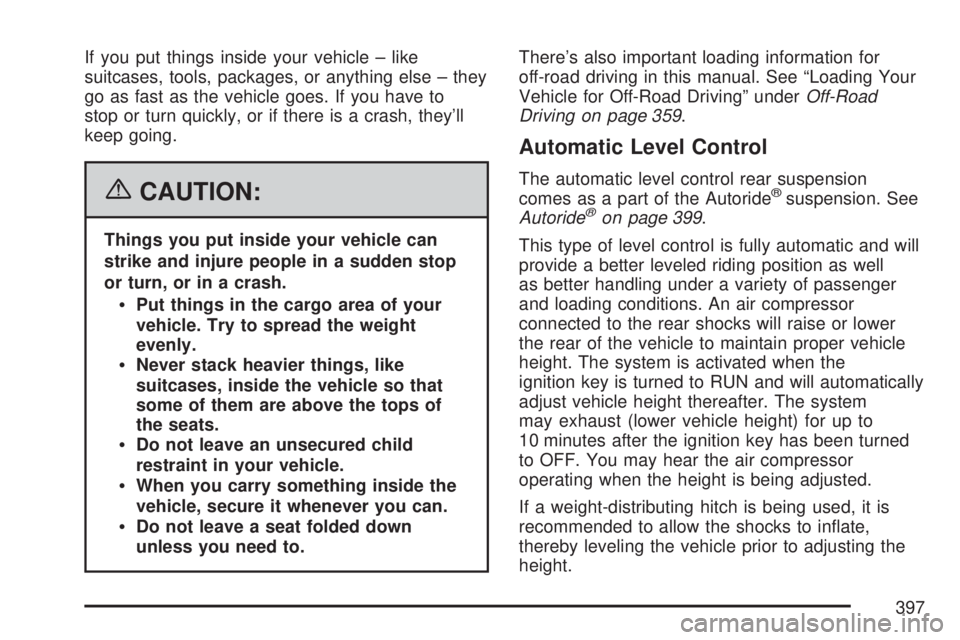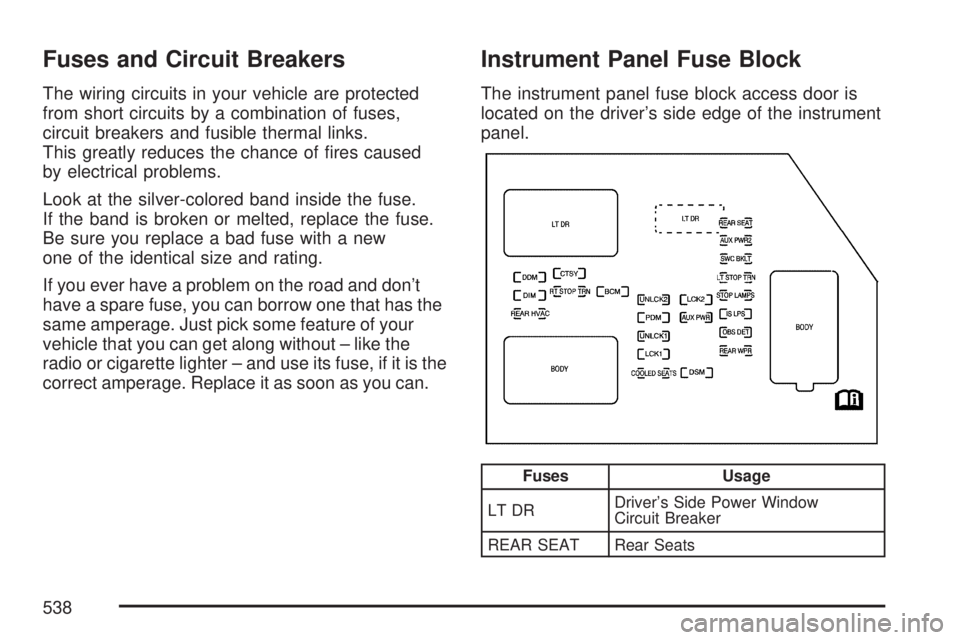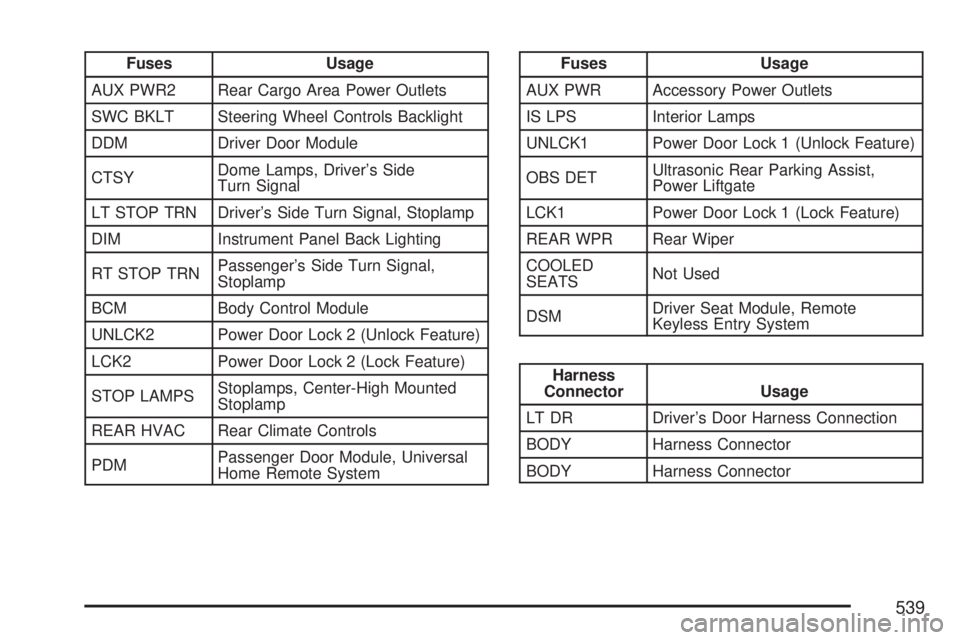2007 GMC YUKON XL DENALI seats
[x] Cancel search: seatsPage 179 of 608

Center Console Storage Area
Your vehicle has a console compartment between
the bucket seats.
To open it, press the button on the front of the
console and swing the console cover open.
The console may be equipped with an accessory
power outlet inside. SeeAccessory Power
Outlet(s) on page 213.
The rear of the console also has a cupholder
that swings down for the rear seat passengers
to use.
Luggage Carrier
You can load things on top of your vehicle with
this feature.
The luggage carrier has slats and siderails
attached to the roof and crossrails which can be
moved back and forth to help secure cargo. Tie the
load to the siderails or siderail supports.Notice:Loading cargo on the luggage carrier
that weighs more than 200 lbs (91 kg) or
hangs over the rear or sides of the vehicle
may damage your vehicle. Load cargo so that
it rests on the slats as far forward as
possible and against the side rails, making
sure to fasten it securely.
Don’t exceed the maximum vehicle capacity when
loading your vehicle. For more information on
vehicle capacity and loading, seeLoading Your
Vehicle on page 392.
To prevent damage or loss of cargo as you’re
leaving, check now and then to make sure
the luggage and cargo are still securely fastened.
Be sure the cargo is properly loaded.If small heavy objects are placed on the roof,
place the load in the area over the rear
wheels (behind the rear side door on
Yukon XL Denali models). If you need to, cut
a piece of 3/8 inch plywood to �t inside
the crossrails and siderails to spread the load.
If plywood is used, tie it to the siderail
supports.
179
Page 220 of 608

The interior temperature sensors located in the
headliner above the driver side seat and in
the headliner above the second row seats
measure the temperature of the air inside your
vehicle.There is also an exterior temperature sensor
located behind the front grille. This sensor reads
the outside air temperature and helps maintain the
temperature inside the vehicle. Any cover on
the front of the vehicle could cause a false reading
in the displayed temperature.
The climate control system uses the information
from these sensors to maintain your comfort setting
by adjusting the outlet temperature, fan speed, and
the air delivery mode. The system may also supply
cooler air to the side of the vehicle facing the sun.
The recirculation mode will also be used as needed
to maintain cool outlet temperatures.
220
Page 222 of 608

Rear Window Defogger
The rear window defogger uses a warming grid to
remove fog from the rear window.
<(Rear Window Defogger):Press this button
to turn on the rear window defogger. It will
automatically turn off several minutes after it
has been activated. The defogger can also be
turned off by pressing the button again or by
turning off the engine. Do not drive the vehicle until
all the windows are clear.
If your vehicle has heated outside rearview
mirrors, the mirrors will heat to help clear fog or
frost from the surface of the mirror when the
rear window defog button is pressed.
Notice:Do not use a razor blade or sharp
object to clear the inside rear window. Do not
adhere anything to the defogger grid lines
in the rear glass. These actions may damage
the rear defogger. Repairs would not be
covered by your warranty.
Outlet Adjustment
Use the air outlets located in the center and on
the side of your instrument panel to direct
the air�ow.
Operation Tips
Keep the hood and front air inlets free of ice,
snow, or any other obstruction (such as
leaves). The heater and defroster will work
better, reducing the chance of fogging
the inside of your windows.
When you enter a vehicle in cold weather, set
the fan speed to maximum air�ow for a few
moments before driving. This helps clear
the intake ducts of snow and moisture, and
reduces the chance of fogging the inside
of your window.
Keep the air path under the front seats clear
of objects. This helps air to circulate
throughout your vehicle.
222
Page 397 of 608

If you put things inside your vehicle – like
suitcases, tools, packages, or anything else – they
go as fast as the vehicle goes. If you have to
stop or turn quickly, or if there is a crash, they’ll
keep going.
{CAUTION:
Things you put inside your vehicle can
strike and injure people in a sudden stop
or turn, or in a crash.
Put things in the cargo area of your
vehicle. Try to spread the weight
evenly.
Never stack heavier things, like
suitcases, inside the vehicle so that
some of them are above the tops of
the seats.
Do not leave an unsecured child
restraint in your vehicle.
When you carry something inside the
vehicle, secure it whenever you can.
Do not leave a seat folded down
unless you need to.There’s also important loading information for
off-road driving in this manual. See “Loading Your
Vehicle for Off-Road Driving” underOff-Road
Driving on page 359.
Automatic Level Control
The automatic level control rear suspension
comes as a part of the Autoride®suspension. See
Autoride®on page 399.
This type of level control is fully automatic and will
provide a better leveled riding position as well
as better handling under a variety of passenger
and loading conditions. An air compressor
connected to the rear shocks will raise or lower
the rear of the vehicle to maintain proper vehicle
height. The system is activated when the
ignition key is turned to RUN and will automatically
adjust vehicle height thereafter. The system
may exhaust (lower vehicle height) for up to
10 minutes after the ignition key has been turned
to OFF. You may hear the air compressor
operating when the height is being adjusted.
If a weight-distributing hitch is being used, it is
recommended to allow the shocks to in�ate,
thereby leveling the vehicle prior to adjusting the
height.
397
Page 485 of 608

Tire Terminology and De�nitions
Air Pressure:The amount of air inside the tire
pressing outward on each square inch of the
tire. Air pressure is expressed in pounds
per square inch (psi) or kilopascal (kPa).
Accessory Weight:This means the combined
weight of optional accessories. Some examples of
optional accessories are, automatic transmission,
power steering, power brakes, power windows,
power seats, and air conditioning.
Aspect Ratio:The relationship of a tire’s height
to its width.
Belt:A rubber coated layer of cords that is
located between the plies and the tread. Cords
may be made from steel or other reinforcing
materials.
Bead:The tire bead contains steel wires wrapped
by steel cords that hold the tire onto the rim.
Bias Ply Tire:A pneumatic tire in which the plies
are laid at alternate angles less than 90 degrees
to the centerline of the tread.Cold Tire Pressure:The amount of air pressure
in a tire, measured in pounds per square inch
(psi) or kilopascals (kPa) before a tire has built up
heat from driving. SeeIn�ation - Tire Pressure
on page 488.
Curb Weight:This means the weight of a motor
vehicle with standard and optional equipment
including the maximum capacity of fuel, oil, and
coolant, but without passengers and cargo.
DOT Markings:A code molded into the sidewall
of a tire signifying that the tire is in compliance
with the U.S. Department of Transportation (DOT)
motor vehicle safety standards. The DOT code
includes the Tire Identi�cation Number (TIN),
an alphanumeric designator which can also identify
the tire manufacturer, production plant, brand,
and date of production.
GVWR:Gross Vehicle Weight Rating. See
Loading Your Vehicle on page 392.
GAWR FRT:Gross Axle Weight Rating for the
front axle. SeeLoading Your Vehicle on page 392.
GAWR RR:Gross Axle Weight Rating for the
rear axle. SeeLoading Your Vehicle on page 392.
485
Page 517 of 608

{CAUTION:
Incorrect wheel nuts or improperly
tightened wheel nuts can cause the wheel
to come loose and even come off. This
could lead to an accident. Be sure to use
the correct wheel nuts. If you have to
replace them, be sure to get new GM
original equipment wheel nuts. Stop
somewhere as soon as you can and have
the nuts tightened with a torque wrench
to the proper torque speci�cation. See
Capacities and Specifications on page 546
for wheel nut torque speci�cation.
Notice:Improperly tightened wheel nuts can
lead to brake pulsation and rotor damage.
To avoid expensive brake repairs, evenly
tighten the wheel nuts in the proper sequence
and to the proper torque speci�cation. See
Capacities and Specifications on page 546
for the wheel nut torque speci�cation.10. Tighten the nuts �rmly in a crisscross
sequence as shown by turning the wheel
wrench clockwise.
When you reinstall the regular wheel and tire,
you must also reinstall the either the center cap,
or bolt-on hub cap, depending on what your
vehicle has. For center caps, place the cap on the
wheel and tap it into place until it seats �ush
with the wheel. The cap only goes on one way.
Be sure to line up the tab on the center cap
with the indentation on the wheel. For bolt-on hub
caps, align the plastic nut caps with the wheel
nuts and then tighten by hand. Then use the
wheel wrench to tighten.
517
Page 538 of 608

Fuses and Circuit Breakers
The wiring circuits in your vehicle are protected
from short circuits by a combination of fuses,
circuit breakers and fusible thermal links.
This greatly reduces the chance of �res caused
by electrical problems.
Look at the silver-colored band inside the fuse.
If the band is broken or melted, replace the fuse.
Be sure you replace a bad fuse with a new
one of the identical size and rating.
If you ever have a problem on the road and don’t
have a spare fuse, you can borrow one that has the
same amperage. Just pick some feature of your
vehicle that you can get along without – like the
radio or cigarette lighter – and use its fuse, if it is the
correct amperage. Replace it as soon as you can.
Instrument Panel Fuse Block
The instrument panel fuse block access door is
located on the driver’s side edge of the instrument
panel.
Fuses Usage
LT DRDriver’s Side Power Window
Circuit Breaker
REAR SEAT Rear Seats
538
Page 539 of 608

Fuses Usage
AUX PWR2 Rear Cargo Area Power Outlets
SWC BKLT Steering Wheel Controls Backlight
DDM Driver Door Module
CTSYDome Lamps, Driver’s Side
Turn Signal
LT STOP TRN Driver’s Side Turn Signal, Stoplamp
DIM Instrument Panel Back Lighting
RT STOP TRNPassenger’s Side Turn Signal,
Stoplamp
BCM Body Control Module
UNLCK2 Power Door Lock 2 (Unlock Feature)
LCK2 Power Door Lock 2 (Lock Feature)
STOP LAMPSStoplamps, Center-High Mounted
Stoplamp
REAR HVAC Rear Climate Controls
PDMPassenger Door Module, Universal
Home Remote SystemFuses Usage
AUX PWR Accessory Power Outlets
IS LPS Interior Lamps
UNLCK1 Power Door Lock 1 (Unlock Feature)
OBS DETUltrasonic Rear Parking Assist,
Power Liftgate
LCK1 Power Door Lock 1 (Lock Feature)
REAR WPR Rear Wiper
COOLED
SEATSNot Used
DSMDriver Seat Module, Remote
Keyless Entry System
Harness
Connector Usage
LT DR Driver’s Door Harness Connection
BODY Harness Connector
BODY Harness Connector
539